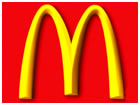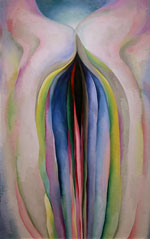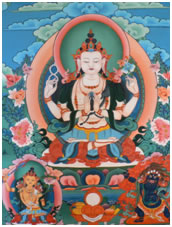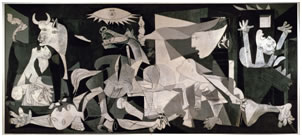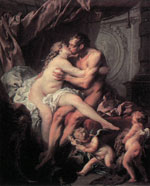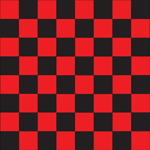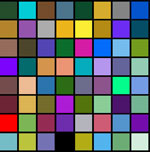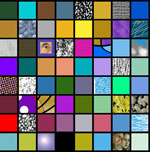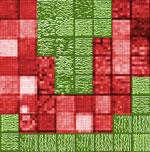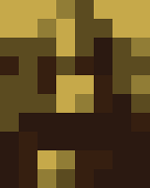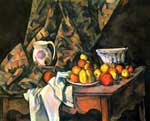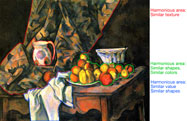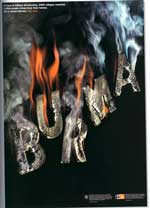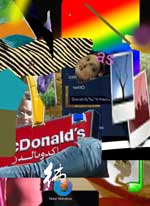Components of Art
FORM, CONTENT and SUBJECT MATTER
Form
Media, Format, and The Elements of Design
Form includes the actual, physical materials that the artist has used, the principles of design,
and the elements of design that they have employed. 
- Media~ The material that is used to physically create the design or other artwork:
- India ink on paper
- Gouache on Bristol board.
- Giclée print (or Ink jet print) on rives BFK paper: Giclée is a neologism coined in 1991 by printmaker Jack Duganne for fine art digital prints made on ink-jet printers. The name originally applied to fine art prints created on IRIS printers in a process invented in the late 1980s but has since come to mean any high quality ink-jet print and is often used by artist, galleries, and print shops to denote such prints. (Duganne) was specifically looking for a word that would not have the negative connotations of "ink-jet" or "computer generated." To make the word descriptive of ink-jet technologies he based it on the French language word "le gicleur" meaning "nozzle", or more specifically "gicler" meaning "to squirt, spurt, or spray". ~ http://en.wikipedia.org/wiki/Giclee
- Serigraphy (screen printing). A group of artists who later formed the National Serigraphic Society coined the word "Serigraphy" in the 1930s to differentiate the artistic application of screen printing from the industrial use of the process. "Serigraphy" is a combination word from the Latin word "Seri" (silk) and the Greek word "graphein" (to write or draw). ~ http://en.wikipedia.org/wiki/Screen_printing
- Oil on canvas
- Sand, glue, steel
- And lots of other stuff.
- Format ~ one of the physical aspects of a design.
- Elements of Design
- Line
- Shape
- Value
- Texture
- Space
- Color
The following elements relate and interact with the format and each other:
Content
Symbols |
 |
 |
 |
Propaganda |
 |
Subject Matter
General stylistic approaches to Subject Matter
AbstractionPartial- or semi-abstraction... Partly representational but simplified and rearranged. |
 |
 |
 |
Non-objective/non-representational
|
|
 |
 |
 |
|
NOTE: Traditionally, a work of art or design may be analyzed as to its form, content and subject matter. But, this may or may not be so in
non-representational work, where the subject is frequently the work itself and the content may be the release of the inner spirit of the artist.
Unity, Variety and Balance: Three Principles of Traditional Composition & Design
Unity
Unity... the quality of oneness. Unity refers to the sense that all of the parts of the artwork are working together to achieve a common result; a harmony of all the parts.
Visual unity is one of the most important aspects of well-developed art and is frequently planned by the artist... if not planned, it is considered and acted upon by the artist.
When nothing distracts from the whole, you have unity.
Unity with diversity generally has more to offer in both art and in life.
Variety
Variety refers to differences or contrasts in values, colors, textures, shapes, and other elements.
Contrasts can create visual excitement, and add interest to the work.
Balance
Balance in a work of art is the distribution of visual weight.
In a traditional sense, a composition should not be too heavy on either side... and it should be a little bottom heavy.
More about balance next class.
Assignment| 1. On a sheet of Bristol Board, create a blind contour drawing, LIGHTLY, in pencil. |  |
Use paints to create a balanced unified composition. Do not blend paints. Leave them hard-edges. Unity, Variety, Balance! |
 |
Random Thoughts:
Alfred Stieglitz, Photographer~ "I have always been a great believer in today. Most people live either in the past or in the future, so that they really never live at all. So many people are busy worrying about the future of art or society, they have no time to preserve what is. Utopia is in the moment. Not in some future time, some other place, but in the here and now, or else it is nowhere."
Stephen Colbert, political satirist ~ "If this is going to be a Christian nation that doesn't help the poor, either we've got to pretend that Jesus was just as selfish as we are, or we've got to acknowledge that he commanded us to love the poor and serve the needy without condition and then admit that we just don't want to do it."
Charlotte Jirousek ~ “Those who understand nonverbal, especially visual language can and do manipulate our attitudes to suit their purposes. Yet often we respond to visual messages unconsciously, preferring to believe that our opinions are formed by our own good judgment and personal taste. Therefore we may fail to recognize that visual signals may affect our opinions about policy issues and social values, or even our preferences in cars, music, or fashions.
For example, the body language, dress, and expressions of a politician in this television age often seem to be as crucial to the success of a party's program as the policies and ideas he holds. The wrong nonverbal signals, and we simply do not trust that person on the screen, whatever his ideals and character may really be. On the other hand, effective use of visual signals can make us overlook a great deal in a politician's background. There have been many examples of both situations in the last 40 years, since television has become such a powerful presence in American life.”
Georgia O'Keeffe~ "I hate flowers - I paint them because they're cheaper than models and they don't move."


